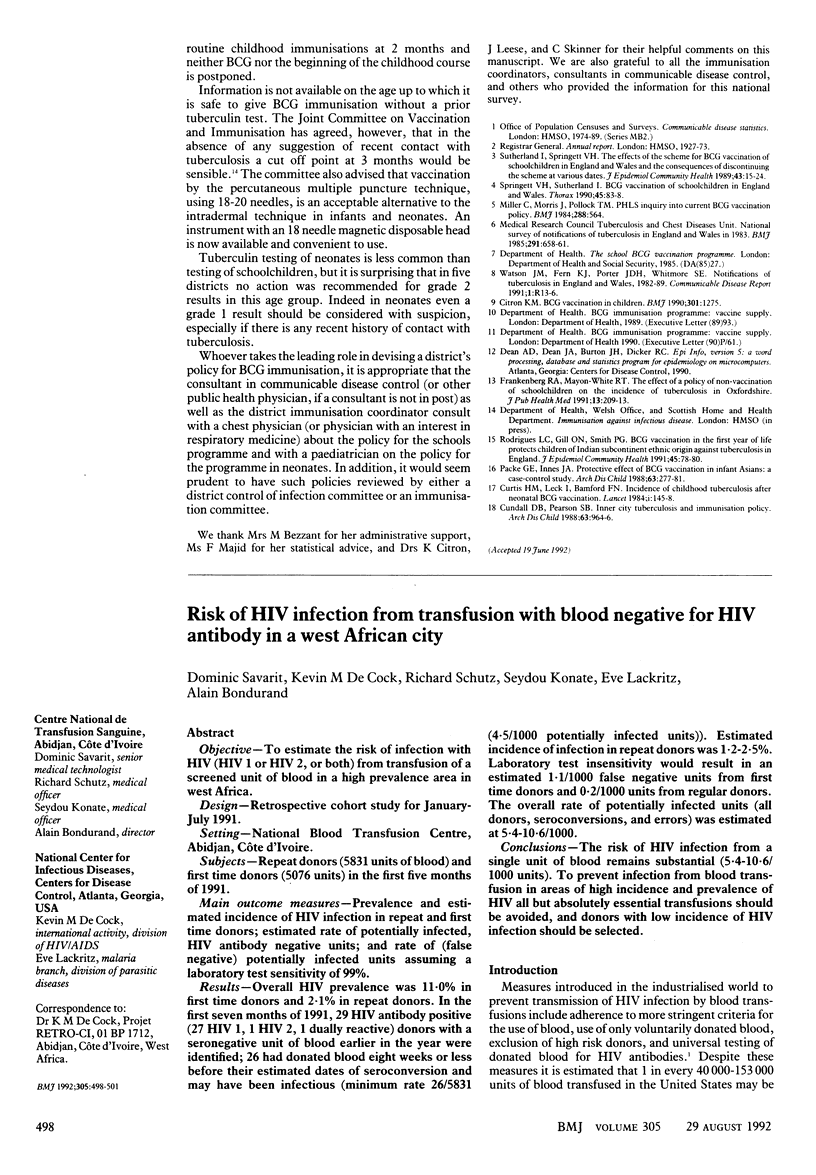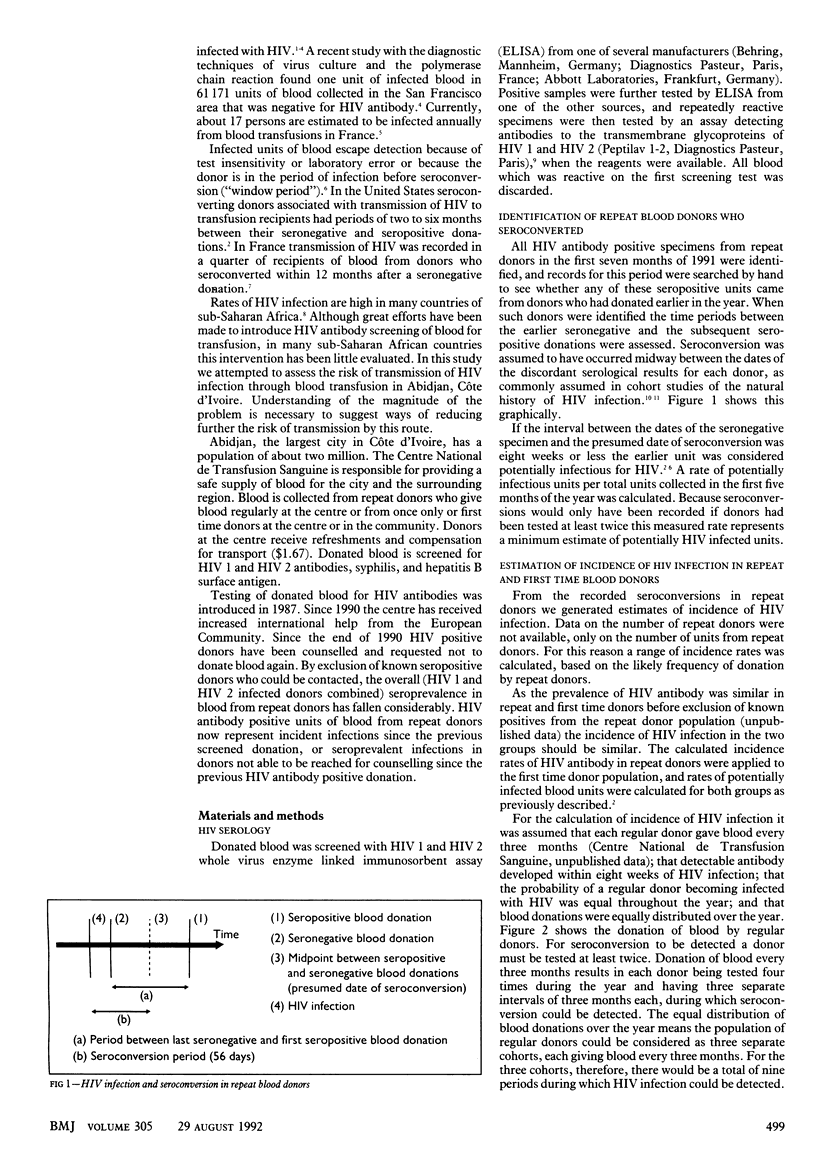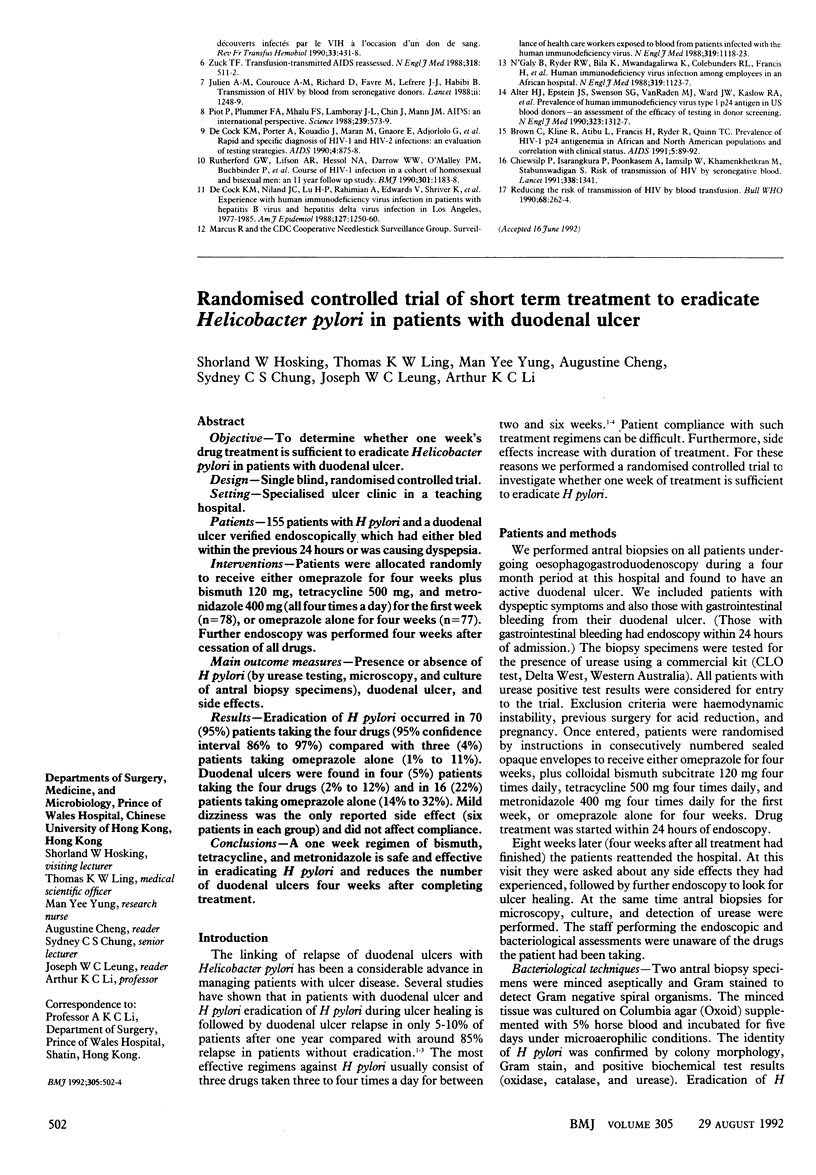Abstract
OBJECTIVE--To estimate the risk of infection with HIV (HIV 1 or HIV 2, or both) from transfusion of a screened unit of blood in a high prevalence area in west Africa. DESIGN--Retrospective cohort study for January-July 1991. SETTING--National Blood Transfusion Centre, Abidjan, Côte d'Ivoire. SUBJECTS--Repeat donors (5831 units of blood) and first time donors (5076 units) in the first five months of 1991. MAIN OUTCOME MEASURES--Prevalence and estimated incidence of HIV infection in repeat and first time donors; estimated rate of potentially infected, HIV antibody negative units; and rate of (false negative) potentially infected units assuming a laboratory test sensitivity of 99%. RESULTS--Overall HIV prevalence was 11.0% in first time donors and 2.1% in repeat donors. In the first seven months of 1991, 29 HIV antibody positive (27 HIV 1, 1 HIV 2, 1 dually reactive) donors with a seronegative unit of blood earlier in the year were identified; 26 had donated blood eight weeks or less before their estimated dates of seroconversion and may have been infectious (minimum rate 26/5831 (4.5/1000 potentially infected units)). Estimated incidence of infection in repeat donors was 1.2-2.5%. Laboratory test insensitivity would result in an estimated 1.1/1000 false negative units from first time donors and 0.2/1000 units from regular donors. The overall rate of potentially infected units (all donors, seroconversions, and errors) was estimated at 5.4-10.6/1000. CONCLUSIONS--The risk of HIV infection from a single unit of blood remains substantial (5.4-10.6/1000 units). To prevent infection from blood transfusion in areas of high incidence and prevalence of HIV all but absolutely essential transfusions should be avoided, and donors with low incidence of HIV infection should be selected.
Full text
PDF




Selected References
These references are in PubMed. This may not be the complete list of references from this article.
- Alter H. J., Epstein J. S., Swenson S. G., VanRaden M. J., Ward J. W., Kaslow R. A., Menitove J. E., Klein H. G., Sandler S. G., Sayers M. H. Prevalence of human immunodeficiency virus type 1 p24 antigen in U.S. blood donors--an assessment of the efficacy of testing in donor screening. The HIV-Antigen Study Group. N Engl J Med. 1990 Nov 8;323(19):1312–1317. doi: 10.1056/NEJM199011083231905. [DOI] [PubMed] [Google Scholar]
- Brown C., Kline R., Atibu L., Francis H., Ryder R., Quinn T. C. Prevalence of HIV-1 p24 antigenemia in African and North American populations and correlation with clinical status. AIDS. 1991 Jan;5(1):89–92. doi: 10.1097/00002030-199101000-00013. [DOI] [PubMed] [Google Scholar]
- Chiewsilp P., Isarangkura P., Poonkasem A., Iamsilp W., Khamenkhetkran M., Stabunswadigan S. Risk of transmission of HIV by seronegative blood. Lancet. 1991 Nov 23;338(8778):1341–1341. doi: 10.1016/0140-6736(91)92650-q. [DOI] [PubMed] [Google Scholar]
- Cumming P. D., Wallace E. L., Schorr J. B., Dodd R. Y. Exposure of patients to human immunodeficiency virus through the transfusion of blood components that test antibody-negative. N Engl J Med. 1989 Oct 5;321(14):941–946. doi: 10.1056/NEJM198910053211405. [DOI] [PubMed] [Google Scholar]
- De Cock K. M., Niland J. C., Lu H. P., Rahimian A., Edwards V., Shriver K., Govindarajan S., Redeker A. G. Experience with human immunodeficiency virus infection in patients with hepatitis B virus and hepatitis delta virus infections in Los Angeles, 1977-1985. Am J Epidemiol. 1988 Jun;127(6):1250–1260. doi: 10.1093/oxfordjournals.aje.a114917. [DOI] [PubMed] [Google Scholar]
- De Cock K. M., Porter A., Kouadio J., Maran M., Gnaore E., Adjorlolo G., Lafontaine M. F., Bretton G., Damet G. M., Odehouri K. Rapid and specific diagnosis of HIV-1 and HIV-2 infections: an evaluation of testing strategies. AIDS. 1990 Sep;4(9):875–878. doi: 10.1097/00002030-199009000-00007. [DOI] [PubMed] [Google Scholar]
- Jullien A. M., Courouce A. M., Richard D., Favre M., Lefrere J. J., Habibi B. Transmission of HIV by blood from seronegative donors. Lancet. 1988 Nov 26;2(8622):1248–1249. doi: 10.1016/s0140-6736(88)90836-7. [DOI] [PubMed] [Google Scholar]
- N'Galy B., Ryder R. W., Bila K., Mwandagalirwa K., Colebunders R. L., Francis H., Mann J. M., Quinn T. C. Human immunodeficiency virus infection among employees in an African hospital. N Engl J Med. 1988 Oct 27;319(17):1123–1127. doi: 10.1056/NEJM198810273191704. [DOI] [PubMed] [Google Scholar]
- Piot P., Plummer F. A., Mhalu F. S., Lamboray J. L., Chin J., Mann J. M. AIDS: an international perspective. Science. 1988 Feb 5;239(4840):573–579. doi: 10.1126/science.3277271. [DOI] [PubMed] [Google Scholar]
- Rutherford G. W., Lifson A. R., Hessol N. A., Darrow W. W., O'Malley P. M., Buchbinder S. P., Barnhart J. L., Bodecker T. W., Cannon L., Doll L. S. Course of HIV-I infection in a cohort of homosexual and bisexual men: an 11 year follow up study. BMJ. 1990 Nov 24;301(6762):1183–1188. doi: 10.1136/bmj.301.6762.1183. [DOI] [PMC free article] [PubMed] [Google Scholar]
- Ward J. W., Holmberg S. D., Allen J. R., Cohn D. L., Critchley S. E., Kleinman S. H., Lenes B. A., Ravenholt O., Davis J. R., Quinn M. G. Transmission of human immunodeficiency virus (HIV) by blood transfusions screened as negative for HIV antibody. N Engl J Med. 1988 Feb 25;318(8):473–478. doi: 10.1056/NEJM198802253180803. [DOI] [PubMed] [Google Scholar]


